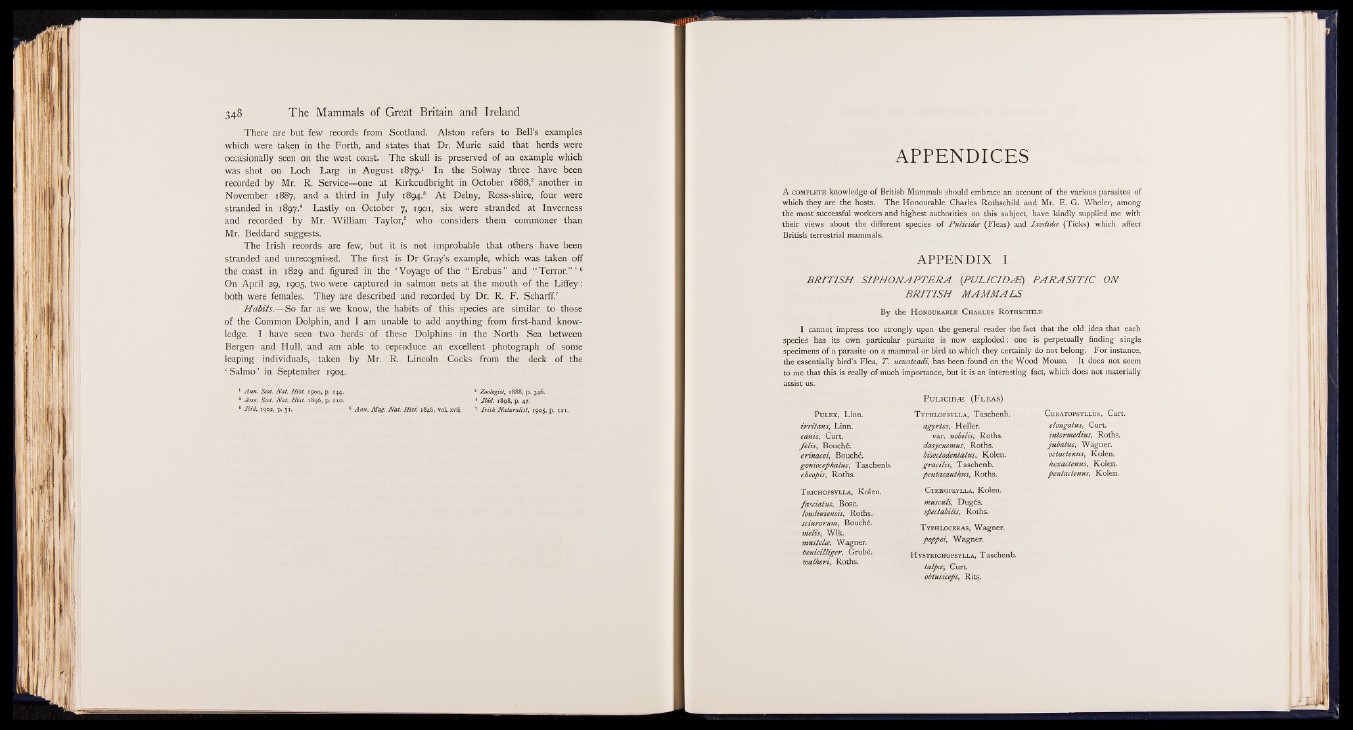
There are but few records from Scotland. Alston refers to Bell’s examples
which were taken in the Forth, and states that Dr. Murie said that herds were
occasionally seen on the west coast. The skull is preserved of an example which
was shot on Loch Larg in August 1879.1 In the Solway three have been
recorded by Mr. R. Service— one at Kirkcudbright in October i888,2 another in
November 1887, and a third in July 1894.® At Delny, Ross-shire, four were
stranded in 1897.4 Lastly on October 7, 1901, six were stranded at Inverness
and recorded by Mr. William Taylor,6 who considers them commoner than
Mr. Beddard suggests.
The Irish records are few, but it is not improbable that others have been
stranded and unrecognised. The first is Dr Gray’s example, which was taken off
the coast in 1829 and figured in the ‘Voyage of the “ Erebus” and “ Terror.” ’ 6
On April 29, 1905, two were captured in salmon nets at the mouth of the Liffey:
both were females. They are described and recorded by Dr. R. F. Scharff.7
H abits.— So far as we know, the habits of this species are similar to those
of the Common Dolphin, and I am unable to add anything from first-hand knowledge.
I have seen two herds of these Dolphins in the North Sea between
Bergen and Hull, and am able to reproduce an excellent photograph of some
leaping individuals, taken by Mr. R. Lincoln Cocks from the deck of the
‘ Salmo’ in September 1904.
1 Ann. Scot. Nat. H ist. 1900, p. 244. 2 Zoologist, 1888, p. 346.
3 Ann. Scot. Nat. H ist. 1896, p. 210. 4 Ibid. 1898, p. 47.
6 Ibid. 1902, p. 51. 6 Ann. Mag. Nat. H ist. 1846, vol. xvii. ' 7 Irish Naturalist, 1905, p. 121.
APPENDICES
A complete knowledge o f British Mammals should embrace an account o f the various parasites of
which they are the hosts. T h e Honourable Charles Rothschild and Mr. E. G. Wheler, among
the most successful workers and highest authorities on this subject, have kindly supplied me with
their views about the different species o f Pulicidee (Fleas) and Ixodida (Ticks) which affect
British terrestrial mammals.
A P P E N D IX I
B R IT ISH S IPH O N A F T E R A (PU L IC ID Æ ) P A R A S IT IC ON
B R IT ISH M AM M A L S
By the Honourable Charles R othschild
I cannot impress too strongly upon the general reader the fact that the old idea that each
species has its own particular parasite is now exploded: one is perpetually finding single
specimens o f a parasite on a mammal or bird to which they certainly do not belong. F or instance,
the essentially bird’s Flea, T . newsteadi, has been found on the Wood Mouse. It does not seem
to me that this is really o f much importance, but it is an interesting fact, which does not materially
assist us.
Pulex, Linn.
irritan s, Linn.
canis, Curt.
fe lis , Bouché.
erinacei, Bouché.
goniocephalus, Taschenb.
cheopis, Roths.
T richopsylla, Kolen.
fasciatus, Bose.
londiniensis, Roths.
sciurorum, Bouché.
metis, Wlk.
mustelie, Wagner.
■ benicilliger, Grubé.
walkeri, Roths.
P u L i c iD iE ( F l e a s )
T yphlopsylla, Taschenb.
agyrtes, Heller.
var. nobilis, Roths.
dasycnemus, Roths.
bisoctodentatus, Kolen.
g ra cilis, Taschenb.
pentacantkus, Roths.
Ctenopsylla, Kolen.
m usculi, Dug£s.
speciabilis, Roths.
T yphloceras, Wagner.
poppei, Wagner.
H ystrichopsylla, Taschenb.
talpee. Curt.
obtusiceps, Rits.
C eratopsyllus, Curt.
elongatus, Curt.
interm edius, Roths.
jubatus, Wagner.
octactenus, Kolen.
hexactenus, Kolen.
pentactenus, Kolen.